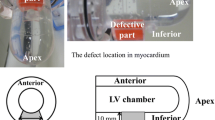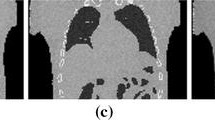Abstract
Background
Our objective was to study the differences in relative count distributions in the left ventricular walls with attenuation compensation (AC) versus AC and triple—energy-window scatter compensation (SC), compared with standard filtered backprojection (FBP).
Methods and Results
Two hundred patients identified as having normal cardiac perfusion with FBP after undergoing either pharmacologically or physiologically induced stress were included in this study. Projection data were reconstructed with FBP, 10 iterations of ordered-subset expectation-maximization (OSEM) with AC, and OSEM with AC+SC. A comparison was made of average percentage of maximum counts within each of 9 regions of CEqual (Marconi Medical Systems, Inc, Cleveland, Ohio) polar maps (ie, the apex, 4 midventricular regions, and 4 basal regions). Compared with OSEM(AC), a slight decrease at the apex exists when SC is included. The elevated inferior-to-anterior count ratio in the midventricular and basal regions noted with OSEM(AC) decreased to close to 1.0 with OSEM(AC+SC). The anterior-to-lateral ratio for both regions was closest to 1.0 for OSEM(AC+SC). In the midventricular region, the lateral-to-septal ratio decreased further below 1.0 with OSEM(AC+SC) than it did with OSEM(AC). This was the only basal ratio not to improve to close to 1.0 with OSEM(AC+SC). In a subset of patients identified at the time of clinical reading as having a possible attenuation-caused decrease in the inferior region, AC elevated the inferior-to-anterior ratio to above 1.0 for the midventricular region. AC+SC resulted in a ratio of near 1.0 for this region. In another subset of patients identified as having anterior attenuation artifacts, compensation methods (either AC or AC+SC) failed to show an improvement compared with FBP.
Conclusions
AC and SC improve the uniformity of the polar map, especially by bringing the inferior-to-anterior ratio closer to 1.0. Further investigation is necessary to determine the cause of the increased midventricular septal polar map count. In addition, the subset of patients identified as having breast-like attenuation artifacts causing a decreased polar map count in the anterior wall (relative to the inferior wall) also needs further attention.
Similar content being viewed by others
References
Kahn KJ, McGhie IO, Akers MS, Sills MN, Faber TL, Kulkarni PV, et al. Quantitative rotational tomography with 201-Tl and 99m-Tc-2-methoxy isobutyl-isonitrile. Circulation 1989;79:1282–93.
Maddahi J, Kiat H, Van Train KF, Prigent F, Friedman J, Garcia EV, et al. Myocardial perfusion imaging with technetium-99m sestamibi SPECT in the evaluation of coronary artery disease. Am J Cardiol 1990;66:55E-62E.
DePuey EG, Garcia EVG. Optimal specificity of thallium SPECT through recognition of imaging artifacts. J Nucl Med 1989;30:441–9.
LaCroix KJ, Tsui BMW, Frey EC, Jaszczak RJ. Receiver operating characteristic evaluation of iterative reconstruction with attenuation correction in 99mTc-sestamibi myocardial SPECT Images. J Nucl Med 2000;41:502–13.
Ficaro EP, Fessler JA, Shreve PD, Kritzman JN, Rose PA, Corbett JR. Simultaneous transmission/emission myocardial perfusion tomography: diagnostic accuracy of attenuation-corrected 99mTc-sestamibi single-photon emission computed tomography. Circulation 1996;93:463–73.
Ficaro EP, Fessler JA, Ackermann RJ, Rogers WL, Corbett JR, Schwaiger M. Simultaneous transmission-emission thallium-201 cardiac SPECT: effect of attenuation correction on myocardial tracer distribution. J Nucl Med 1995;36:921–31.
Kluge R, Sattler B, Seese A, Knapp WH. Attenuation correction by simultaneous emission-transmission myocardial single-photon emission tomography using a technetium-99m-labelled radiotracer: impact on diagnostic accuracy. Eur J Nucl Med 1997;24:1107–14.
Links JM, Becker LC, Rigo P, Taillefer R, Hanelin L, Anstett F, et al. Combined correction for attenuation, depth-dependent blur, and motion in cardiac SPECT: a multicenter trial. J Nucl Cardiol 2000;7:414–25.
Hendel RC, Berman DS, Cullom JS, Follansbee W, Heller GV, Kiat H, et al. Multicenter clinical trial to evaluate the efficacy of correction for photon attenuation and scatter in SPECT myocardial perfusion imaging. Circulation 1999;99:2742–9.
Vidal R, Buvat I, Darcourt J, Migneco O, Desvignes P, Baudouy M, et al. Impact of attenuation correction by simultaneous emission/transmission tomography on visual assessment of 201Tl myocardial perfusion images. J Nucl Med 1999;40:1301–9.
Lee DS, So Y, Cheon GJ, Kim KM, Lee MM, Chung J-K. Limited incremental values of attenuation-noncorrected gating and ungated attenuation correction to rest/stress myocardial perfusion SPECT in patients with an intermediate likelihood of coronary artery disease.J Nucl Med 2000;42:852–9.
Wackers FJ. Attenuation correction, or the emperor’s new clothes? [editorial]. J Nucl Med 1999;40:1310–2.
Cullom SJ, Case JA, Bateman TM. Attenuation correction for cardiac SPECT: clinical and developmental challenges [invited commentary]. J Nucl Med 2000;41:860–2.
Taillefer R, DePuey EG, Udelson JE, Beller GA, Benjamin C, Gagnon A. Comparison between the end-diastolic images and the summed images of gated 99mTc-sestamibi SPECT perfusion study in detection of coronary artery disease in women. J Nucl Cardiol 1999;6:169–76.
Ichihara T, Ogawa K, Motomura N, Kubo A, Hasimoto S. Compton scatter compensation using the triple-energy window method for single- and dual-isotope SPECT. J Nucl Med 1993;34:2216–21.
Narayanan MV, King MA, Pan T-S, Dahlberg ST. Investigation of approaches to reduce truncation of attenuation maps with simultaneous transmission and emission SPECT imaging. IEEE Trans Nucl Sci 1998;45:1200–6.
Narayanan MV, King MA, Byrne C. An extension of the maximum-likelihood transmission gradient algorithm to include scatter correction in the simultaneous emission/transmission SPECT imaging [abstract]. J Nucl Med 1999;40:298P.
Garcia EV, Cooke CD, Van Train KF, Folks R, Peifer J, DePuey EG, et al. Technical aspects of myocardial SPECT imaging with technetium-99m sestamibi. Am J Cardiol 1990;66:23E-31E.
Hudson HM, Larkin RS. Accelerated image reconstruction using ordered subsets projection data. IEEE Trans Med Imaging 1994; 13:601–9.
Pollard JH. Numerical and statistical techniques. Cambridge: Cambridge University Press; 1977. p. 175–7.
Narayanan MV, King MA, Leppo J, Dahlberg S, Pretorius PH, et al. Optimization of regularization of attenuation and scatter corrected 99mTc cardiac SPECT studies for defect detection using hybrid images. IEEE Trans Nucl Sci. In press.
King MA, Xia W, De Vries DJ, Pan T-S, Villegas BJ, Dahlberg ST, et al. A Monte Carlo investigation of artifacts caused by liver uptake in single-photon emission computed tomography perfusion imaging with technetium 99m-labeled agents. J Nucl Cardiol 1996;3:18–29.
Nuyts J, Dupont P, Van den Maegdenbergh V, Vleugels S, Suetens P, Mortelmans P. A study of liver-heart artifact in emission tomography. J Nucl Med 1995;36:133–9.
Van Dongen AJ, Van Rijk PP. Minimizing liver, bowl, and gastric activity in myocardial perfusion SPECT. J Nucl Med 2000;41:1315–7.
Rigo P, Van Boxem PH, Foulon J, Saft M, Engdahl J, Links J. Quantitative evaluation of a comprehensive motion, resolution, and attenuation correction program: initial experience. J Nucl Cardiol 1998;5:458–68.
Chouraqui P, Livschitz S, Sharir T, Wainer N, Wilk M, Moalem I, et al. Evaluation of an attenuation correction method for thallium-201 myocardial perfusion tomographic imaging of patients with low likelihood of coronary artery disease. J Nucl Cardiol 1998;5:369–77.
Gallowitsch HJ, Sykora J, Mikosch P, Kresnik E, Unterweger O, Molnar M, et al. Attenuation-corrected thallium-201 single-photon emission tomography using a gadolinium-153 moving line source: clinical value and the impact of attenuation correction on the extent and severity of perfusion abnormalities. Eur J Nucl Med 1998;25:220–8.
Pretorius PH, King MA. A study of possible causes of artifactual decreases in the left ventricular apex with SPECT cardiac imaging. IEEE Trans Nucl Sci 1999;46:1016–23.
Tsui BMW, Segars WP, Lalush DS, Frey EC. Non-clinical factors affecting myocardial intensity uniformity in myocardial perfusion SPECT images [abstract]. J Nucl Med 2000;41:98P.
Pretorius PH, King MA, Tsui BMW, LaCroix KJ, Xia W. A mathematical model of motion of the heart for use in generating source and attenuation maps for simulating emission imaging. Med Phys 1999;26:2323–32.
Pan T-S, King MA, Penney BC, Rajeevan N, Luo D-S, Case JA. Reduction of truncation in fan beam transmission by using parallel beam emission data. IEEE Trans Nucl Sci 1995;42:1310–20.
Author information
Authors and Affiliations
Corresponding author
Rights and permissions
About this article
Cite this article
Pretorius, P.H., Narayanan, M.V., Dahlberg, S.T. et al. The influence of attenuation and scatter compensation on the apparent distribution of Tc-99m sestamibi in cardiac slices. J Nucl Cardiol 8, 356–364 (2001). https://doi.org/10.1067/mnc.2001.113516
Received:
Accepted:
Issue Date:
DOI: https://doi.org/10.1067/mnc.2001.113516




